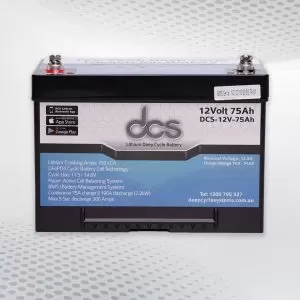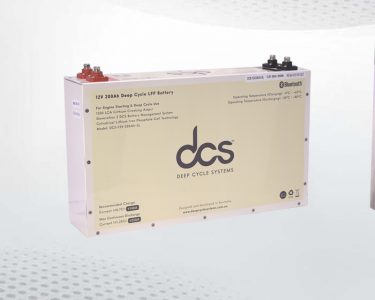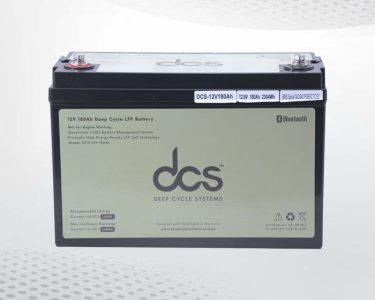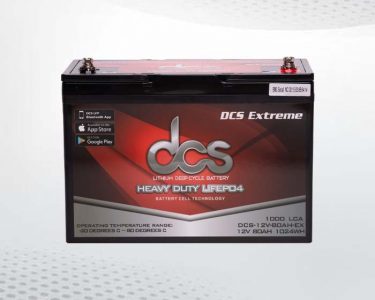Regarding reliable and long-lasting power storage solutions, Deep Cycle-Batteries are the go-to choice for many industries and applications. Deep Cycle Batteries are designed to provide sustained power over an extended period, making them ideal for use in renewable energy systems, marine applications, RVs, golf carts, and more. In this blog post, they will explore the secrets of Deep Cycle-Batteries, from their fundamentals to maintenance tips and misconceptions. Let’s dive deep into deep-cycle batteries and uncover what makes them so special.
The Fundamentals of Deep Cycle-Batteries
Deep Cycle-Batteries stand apart from conventional car batteries due to their unique design, optimised for repeated discharge and recharge cycles. Unlike their automotive counterparts, designed to deliver a large burst of power for a short period, Deep Cycle-Batteries are engineered to provide a consistent power output over a lengthy duration. This capability is particularly beneficial for applications requiring a reliable power source for extended periods, such as in off-grid solar systems, where the battery discharges at night and recharges during the day.
The construction of deep-cycle batteries facilitates a deeper discharge level without inflicting damage, enhancing their suitability for various applications beyond vehicular use, including renewable energy storage, marine vessels, recreational vehicles, and golf carts. This fundamental distinction in design and function underscores the versatility and durability of Deep Cycle-Batteries, establishing them as a cornerstone in systems where sustained power delivery is paramount.
The Variety of Deep Cycle-Batteries Available
The marketplace offers an array of deep-cycle batteries, each tailored for specific needs and applications. Flood lead-acid batteries are notable for their affordability and wide availability, although they require regular maintenance to ensure optimal performance. On the other hand, gel batteries present a more maintenance-free option, with a gel electrolyte that mitigates leakage and reduces the need for upkeep.
Absorbent glass mat (AGM) batteries represent a modern innovation in the field, providing superior performance with a design that accommodates a wide range of temperatures and less maintenance. These batteries, known for their durability and efficiency, are especially suited for applications where reliability is crucial.
While each type exhibits unique attributes, including varying lifespans, charge rates, and capacities, the selection process is critical in matching the right deep cycle-battery to the intended use. Understanding the distinct advantages and potential limitations of flooded lead-acid, gel, and AGM batteries enables informed decision-making for individuals and industries seeking sustainable and dependable power solutions.
The Critical Role of Deep Cycle-Batteries in Renewable Energy
Deep Cycle-Batteries are pivotal in the efficacy and reliability of renewable energy systems, particularly solar and wind power projects. These energy storage solutions harness electricity generated during peak production times—daylight hours for solar panels and periods of significant wind for turbines—and store it for future use. This capability is instrumental in addressing one of renewable energy’s primary challenges: its sources’ intermittent nature.
Unlike traditional power generation methods that can continuously produce energy, renewable sources are subject to environmental conditions. Therefore, deep-cycle batteries bridge the gap, ensuring that power is available even during low or no generation periods. Their ability to withstand prolonged periods of discharge and then be recharged makes them an ideal choice for these systems.
Furthermore, the transition towards renewable energy sources underscores the importance of deep-cycle batteries in achieving energy independence and promoting sustainable and eco-friendly power solutions. Their role in renewable energy systems exemplifies a shift towards more responsible energy storage and consumption practices, aligning with global efforts to combat climate change by reducing reliance on fossil fuels.
How to Choose the Right Deep Cycle Battery
Selecting the appropriate Deep Cycle Battery necessitates a comprehensive evaluation of several key factors to ensure the battery aligns with the specific requirements of the intended application. Here are pivotal considerations to guide the selection process:
Application Requirements
Understand the application’s energy demands. Whether for renewable energy systems, marine use, or recreational vehicles, each application has distinct power requirements that the battery must meet.
Battery Type
Consider the type of deep cycle-battery that best suits the application. Flooded lead-acid batteries are suitable for environments where maintenance isn’t an issue. In contrast, AGM or gel batteries might be preferable for applications requiring minimal maintenance and are more resistant to vibration and shock.
Capacity and Size
Calculate the battery capacity needed to power the application for the desired period. This involves understanding the amp-hour (Ah) requirements and ensuring adequate space for the battery’s physical dimensions.
Depth of Discharge (DOD)
Factor in the battery’s depth of discharge as it influences its lifecycle. Batteries with a higher DOD can endure more extensive discharges without compromising their lifespan.
The Best Practices for Deep Cycle-Battery Maintenance
Ensuring Deep Cycle-Batteries’ prolonged efficiency and functionality hinges on adherence to meticulous maintenance routines. It is paramount to conduct regular inspections of the battery’s water levels, especially in the case of flooded lead-acid types, to maintain optimal electrolyte concentration. Keeping the terminals clean is crucial to prevent corrosion and ensure efficient power flow.
Overcharging or allowing the battery to discharge excessively can severely compromise its longevity and should be vigilantly avoided. Implementing these maintenance strategies is essential for maximising the service life of deep-cycle batteries, facilitating their continued performance across various applications. By dedicating attention to these practices, users can safeguard their investment and uphold the battery’s capacity to deliver reliable power over its designed lifespan.
Common Myths and Misconceptions about Deep Cycle-Batteries
Deep Cycle-Batteries are fraught with myths and misconceptions that can skew perceptions and lead to misuse. A prevalent fallacy is that these batteries can endure indefinite periods without recharging. In truth, to maintain their efficacy and extend their lifecycle, Deep Cycle-Batteries necessitate systematic charging, contrary to the belief that they can be left idle for extended durations.
Another common misunderstanding is that these batteries can be discharged to zero without repercussions. This is a misconception that can significantly impair their longevity and functionality. Discharging beyond recommended levels exposes the batteries to the risk of irreversible damage, undermining their ability to hold a charge in the future. Such myths compromise the performance of Deep Cycle-Batteries and diminish their potential in applications where dependable power is crucial.
It’s essential to navigate these misconceptions with accurate knowledge to harness the full capabilities of deep-cycle batteries and ensure their optimal operation across their intended applications. Dispelling these myths is key to leveraging the technology effectively, fostering a more informed usage that aligns with the batteries’ designed parameters and capabilities.
The Future of Deep Cycle-Batteries
As technological advancements unfold, the evolution of Deep Cycle-Batteries is marked by significant strides towards greater efficiency, longevity, and environmental sustainability. Innovations in materials and manufacturing processes pave the way for these batteries to meet the escalating demand for robust, reliable energy storage solutions. In the vanguard of these advancements are developments aimed at enhancing deep-cycle batteries’ energy density, enabling them to store more power in a smaller footprint.
This is particularly advantageous for applications where space is at a premium, such as electric vehicles and portable power systems. Furthermore, the integration of smart technology into deep-cycle batteries heralds a new era of energy management. Intelligent systems that can monitor and adjust charging cycles in real time are being developed to optimise battery performance, extend service life, and increase efficiency. Such smart batteries are poised to revolutionise energy storage and management, facilitating more seamless integration with renewable energy sources.
Environmental considerations are also at the forefront of the future development of deep-cycle batteries. Research is being channeled into finding more sustainable materials and recycling methods to reduce the environmental footprint of battery production and disposal. As the world gravitates towards greener energy solutions, deep-cycle batteries are set to play a pivotal role in this transition, embodying the synergy between technological innovation and environmental stewardship.
Maximising Your Deep Cycle-Battery’s Lifespan
Extending the service life of deep-cycle batteries requires adherence to certain practices, focused primarily on avoiding overcharging and ensuring the environment in which they are stored is conducive to longevity. The process of overcharging can lead to significant degradation of battery health. Thus, charge levels must be carefully monitored and managed. Storage conditions also play a critical role; batteries benefit from being kept in cool and dry environments, as extreme temperatures and humidity can accelerate wear and reduce efficiency.
Furthermore, cleanliness is paramount in preventing the build-up of dirt and corrosion on connections, which can impede the flow of electricity and lead to increased resistance. Regular checks and maintenance ensure that potential issues can be identified and addressed before impacting the battery’s performance. By focusing on these key areas, the operational life of Deep Cycle-Batteries can be significantly extended, allowing them to continue providing dependable power for longer.
Mastering Deep Cycle-Battery Safety
Ensuring the safety of Deep Cycle-Batteries involves strict adherence to guidelines provided by manufacturers and avoiding interventions in their structural or operational integrity. The handling and usage of these batteries require a cautious approach to prevent potential hazards. Modifications or repairs on damaged units must be left to professionals, as incorrect handling could lead to dire consequences, including injury or significant property damage.
The maintenance of these batteries should follow recommended practices to avoid exposing the battery to conditions that could prompt safety risks. Instances of misuse, such as subjecting the batteries to extreme temperatures or improper charging techniques, have been documented to cause adverse reactions, underscoring the importance of a disciplined maintenance regimen.
Furthermore, implementing safety measures, including using protective equipment when handling batteries and ensuring they are stored in appropriate environments, is crucial in mitigating risks associated with their usage. This focus on safety is not just about preserving the operational integrity of the batteries but also about safeguarding the well-being of individuals who interact with them and the environment in which they are utilised. Such diligence in observing safety protocols ensures the harmonious integration of Deep Cycle-Batteries into various applications without compromising the security of their operational milieu.
Expert Tips for Optimising Deep Cycle-Batteries
Maximising the efficacy and longevity of deep-cycle batteries can be achieved through several strategic practices. A paramount approach includes the investment in a high-quality charger tailored to the specific needs of deep-cycle batteries. Such chargers ensure that the batteries are charged efficiently and help prevent the detrimental effects of overcharging, thereby preserving the battery’s health. Employing a battery monitoring system is another critical step towards optimising battery performance.
These systems provide real-time insights into the battery’s state of charge, health, and overall efficiency, enabling preemptive maintenance and adjustments to enhance longevity. Additionally, establishing a regular maintenance schedule is crucial. This involves checking the batteries for signs of wear, ensuring connections are clean and tight, and verifying that the batteries are stored in conditions that favor their optimum performance. Adherence to these practices promotes the operational excellence of deep-cycle batteries, making them more reliable and extending their serviceable life within various applications.
Conclusion
In summary, Deep Cycle Batteries are critical in pursuing sustainable and reliable energy solutions across many applications. Their unique ability to deliver sustained power and advancements in technology and maintenance practices positions them at the forefront of the energy transition. As industries and individuals increasingly turn towards renewable energy sources, the significance of these batteries in ensuring a consistent power supply cannot be overstated. Through informed selection, diligent maintenance, and adherence to safety protocols, the potential of deep-cycle batteries to support and enhance energy systems around the globe is immense.
FAQS
1. What distinguishes Deep Cycle Battery from regular car batteries?
Deep Cycle Battery are designed to be discharged and recharged multiple times, offering a consistent power output over long periods, unlike car batteries, which deliver short bursts of high power for starting vehicles.
2. Can Deep Cycle-Batteries be used with any renewable energy system?
They are versatile and can be integrated with various renewable energy systems, such as solar and wind power, storing electricity during peak production for later use.
3. How often do different types of deep-cycle batteries require maintenance?
Flooded lead-acid batteries require regular maintenance, including water level checks, whereas gel and AGM batteries are virtually maintenance-free and designed for applications where upkeep is minimal.
4. What is the impact of temperature on deep-cycle batteries?
Extreme temperatures can affect their performance and longevity. Keeping them in a cool, dry place helps maintain their efficiency over time.
5. Is it possible to extend the lifespan of a deep-cycle battery?
Yes, one can significantly extend the operational life of deep-cycle batteries by avoiding overcharging, ensuring they’re stored in appropriate conditions, and maintaining cleanliness to prevent corrosion.
| Related Business Listings |
| Contact Directory |
| Local Business Profiles |








1 Comment